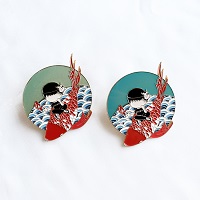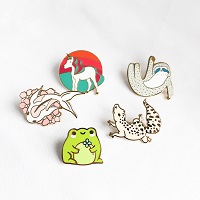Lapel pins are small, customizable accessories that hold significant cultural, promotional,
and sentimental value. From corporate branding to commemorative events, these tiny emblems are a popular way to express identity and solidarity.
However, behind their charm lies an environmental footprint that often goes unnoticed. As consumers and
businesses increasingly prioritize sustainability, understanding the ecological impact of producing lapel pins is essential for making informed choices.

Resource Extraction and Manufacturing
Most lapel pins are made from metals like zinc alloy, copper, or iron,
which require mining—a process linked to habitat destruction, water pollution, and carbon emissions.
Mining operations often leave landscapes scarred and communities displaced, while refining metals consumes vast amounts of energy,
primarily from fossil fuels. Additionally, the electroplating process (used to add colors or finishes)
involves toxic chemicals such as cyanide and heavy metals, which can contaminate waterways if not managed responsibly.
The production of enamel pins, another popular variant, involves heating powdered glass to high temperatures,
further contributing to energy consumption and greenhouse gas emissions. Even packaging materials, often plastic-based,
add to the waste generated by the industry.

Transportation and Carbon Footprint
Lapel pins are typically manufactured in centralized facilities, often overseas,
before being shipped globally. This transportation network—reliant on planes, ships,
and trucks—generates significant carbon emissions. For businesses ordering bulk quantities,
the carbon footprint multiplies, especially when expedited shipping options are used.
Waste and Disposal Challenges
While lapel pins are designed to last, they’re rarely recycled.
Their small size and mixed-material composition (metal, enamel, paint) make them difficult to
process in standard recycling systems. As a result, many end up in landfills,
where metals can leach into soil and water over time. Even biodegradable packaging options are limited in this industry,
leaving plastic waste as a lingering issue.

Steps Toward Sustainable Solutions
The good news? Awareness is growing, and eco-conscious alternatives are emerging.
Here’s how businesses and consumers can reduce the environmental impact of lapel pins:
1 Choose Recycled Materials: Opt for pins made from recycled metals or reclaimed materials to minimize reliance on mining.
2. Eco-Friendly Finishes: Work with manufacturers that use water-based paints or non-toxic electroplating methods.
Certifications like RoHS (Restriction of Hazardous Substances) ensure safer chemical practices.
3. Local Production: Partner with local artisans or factories to cut down on transportation emissions.
4. Sustainable Packaging: Use recycled or biodegradable packaging materials, and avoid single-use plastics.
5. Small-Batch Orders: Overproduction leads to waste. Order only what you need, and consider made-to-order models.
6. Recycling Programs: Some companies now offer take-back programs to repurpose old pins. Encourage customers to return used items for recycling.

The Power of Conscious Choices
As demand for sustainable products rises, manufacturers are increasingly adopting greener practices.
By asking suppliers about their environmental policies, businesses can drive industry-wide change. Consumers, too,
play a role by supporting brands that prioritize eco-friendly production.
Lapel pins don’t have to come at the planet’s expense.
With mindful sourcing, responsible manufacturing, and innovative recycling strategies,
these miniature tokens can become symbols not just of pride, but of environmental stewardship.
Next time you order or wear a lapel pin, remember: even small choices can make a big difference.
Let’s pin down a greener future, one badge at a time.
Post time: Apr-14-2025